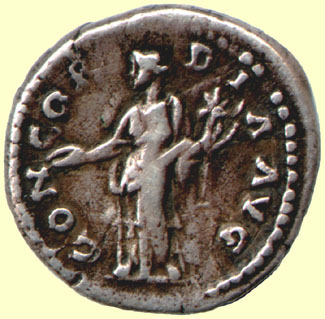 Contents -
Previous Article -
Next Article
Contents -
Previous Article -
Next Article
"I'll cooperate with you for the time being because I need you, Pencil Neck, but as soon as I no longer have use for your services, I'm sending a centurion over with a very sharp sword to slit your worthless throat, you lowlife piece of rat scum!"
One of the best ways to learn about the people of another culture, whether today or long ago, is to read what they have to say about themselves. Though it is interesting to see how a civilization viewed itself and what inspired admiration, loyalty, hatred, or disgust in the breast of the ordinary man or woman. only very rarely will you read the "truth" when you read the words of ancient writers describing events in their own time or the history of their people. What you will find will be a collection of fabrications, tall tales well-told, and outright lies. At about the time of the birth of Christ, the Roman emperor Augustus discovered that there was no real written history of Rome. Indeed, there were very few written records from before 300 B. C., and the truth was that the ancestors of the Romans were rude tribesmen from Latium who emerged from the mists of obscurity to found a small community of huts on the Palatine Hill sometime between 1000 and 750 B. C. Now this kind of boring history would just not do for a proud race of people such as the Romans. So Augustus found Vergil, an educated Roman and a writer, and asked him to remedy the situation. Vergil was kept on as a client by Augustus, who paid him handsomly. For his part, Vergil devoted his life to producing the Aeneid, a stirring epic complete with ancient heroes and beautiful women. The main character Aeneas flees the burning city of Troy carrying his ailing father on his back and has a love affair with an African queen who casts herself upon a funeral pyre when Aeneas sails away and leaves her brokenhearted. The heroic Aeneas ends up defeating fierce Latin tribesmen to found a new nation on the banks of the River Tiber. Augustus loved it. The Roman people ate it up and we’re still reading and enjoying the Aeneid after 2000 years. The only one who didn’t like it was Vergil himself, who thought it imperfect and almost consigned it to the flames until Augustus heard of his intentions and forbade him to do so.
Every once in a while, we will be surprised to discover that a writer has given a fairly balanced and unbiased account of events and often these writers tend to be the less popular and interesting ones! Only after we come to accept and understand this paradox of human nature that we often need to examine legends and lies in order to get at the truth, will we be able to truly understand these people of long ago and how they really are so much like us in many ways. The Roman emperors approached the placement of art and inscriptions on their coins the way Vergil approached the writing of history. So, in the spirit of the Aeneid, let us examine the words, symbols, and art we find on Roman coins.
Go to next article:
Go back to previous article: